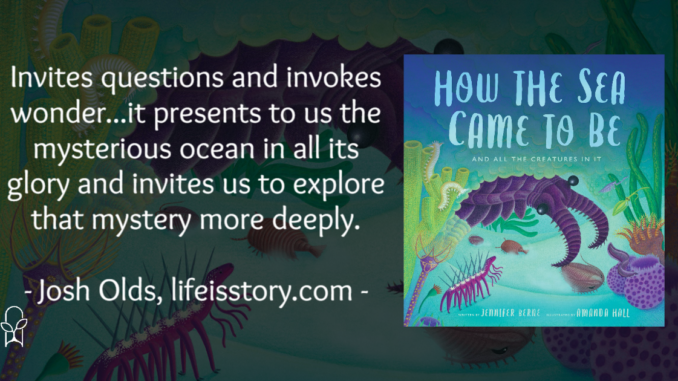
Published by Eerdmans Books for Young Readers on April 25, 2023
Genres: Children's, Children's Educational
Buy on Amazon
Goodreads

A lyrical, spectacular history of the ocean—from its dramatic evolutionary past to its marvelously biodiverse present.
“For millions of years these first bits of life
Became more, and then more, and then more.”Long, long ago, when the Earth was young and new, the world was a fiery place. Volcanoes exploded from deep down below, and steamy, hot clouds rose up high. Rain poured down for thousands of years, filling the world’s very first oceans. There the teeniest stirrings of life began. Earth’s creatures grew bigger and bigger, evolving into exciting forms like jellyfish, coral, and worms. Millions of years passed. Down in the depths and up on the surface, ocean life grew and spread. Now the sea teems with all kinds of animals—squid, turtles, dolphins, barracudas, even glowing fish, all living in the waters where long, long ago, life itself came to be.
Spanning 4.5 billion years of evolution, this extensively researched book is an accessible introduction to geology, oceanography, and marine biology. Entrancing verse, awe-inspiring art, and fascinating back matter capture the mysterious beauty of the ocean and the incredible organisms who call it home.
How the Sea Came to Be is an exploration of primordial evolution. In rhyming verse, Jennifer Berne begins with a burning, volcanic earth that over millions of years cools and builds up steam that finally builds into clouds that cause the torrential rains that carved out the seas. From there, it turns to the birth of life in the sea, from single-celled organisms to more complex and colorful lifeforms, to sentient life. The third part of the book details how, over the millions of years that followed, the sea gave birth to life on land even as more complex and multi-faceted creatures began to grow.
The final pages of the book are a note from the author and illustrator detailing the research that went into their work. Often, I think, readers imagine the illustrator as simply drawing what the author writes, but it is much more complex than that. Illustrator Amanda Hall recounts how she reached out to experts in the field and visited museums to get an idea of how to bring the primordial world to life. There’s an elaborate fold-out panel that offers an overview of ocean creatures over time before How the Sea Came to Be concludes with a glossary and recommended reading for future research.
How the Sea Came to Be is stunningly illustrated. Hall captures the brilliance and variance of ocean life throughout the millennia in a way that is eye-catching and captivating. Berne’s lyrical text provides a clear and simple explanation of the evolutionary process. Moving complex and hypothetical science into clear and concise terms isn’t always easy. Berne and Hall helped me envision evolutionary theory more clearly than I ever had before.
As you might have guessed, this book is a thoroughly secular science book. Even though Eerdman’s publishes Christian non-fiction, its children’s imprint publishes books for both religious and secular tastes. That said, there is no explicit denial of an external creator—and the book is silent on how the first things came to be and how life appeared in the ocean. For those exploring the concept of theistic evolution, this would be an appropriate resource. For those expecting a religious story of creation, it is not—and I shan’t criticize a book for not being something it is not trying to be.
What How the Sea Came to Be does to is invite questions and invoke wonder. It presents to us the mysterious ocean in all its glory and invites to explore that mystery deeper, and for that it ought to be treasured.
